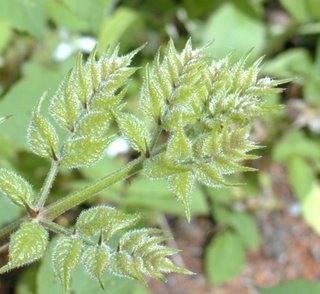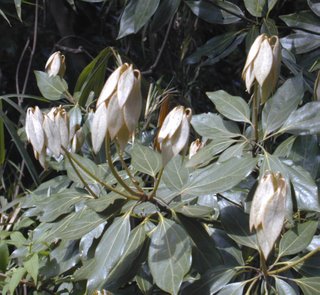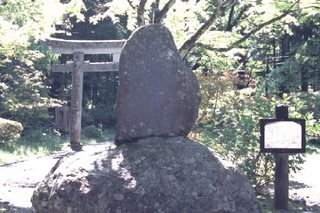. Oku no Hosomichi - 奥の細道 .
:::::::::::::::::::::::::::::::::::::::::::::::::::::::::::::::::::::::::::::::::::::::::::::::::::::
...... あらたふと青葉若葉の日の光

ara tooto aoba wakaba no hi no hikari

© by Gabi Greve, 2006.
Nikko was the 5th station on Basho's travel to the deep North of Japan.
Please read his diary and a discussion here and come back.
"The Narrow Road to the Deep North", by Nobuyuki Yuasa.
Haiku about holiness and awe (tootoi) by
. Matsuo Basho 松尾芭蕉 - Archives of the WKD .
:::::::::::::::::::::::::::::::::::::::::::::::::::::::::::::::::::::::::::::::::::::::::::::::::::::

Nikko
Toshi Yoshida (1911-1995)
Matsuo Basho writes :
On the first day of fourth month, we paid our respects to The Mountain. In ancient times the name of this mountain used to be written to read Mount Two Disasters, but when the Great Teacher Kukai founded the temple, he changed it to Sunlight.
He must have foreseen the future a thousand years ahead: today the light from this place illuminates the entire heaven, its beneficience fills the whole land, and the easeful home for all four classes of people is peaceful. Awestruck, i was barely able to take up my brush:
Look, so holy:
green leaves young leaves
in the light of the sun
http://onegaishimasu.blogspot.com/2004/12/basho-writes-on-first-day-of-fourth.html
:::::::::::::::::::::::::::::::::::::::::::::::::::::::::::::::::::::::::::::::::::::::::::::::::::::
Nikkoo is surrounded by mountains and ancient forest, and is much visited in the autumn for its maple leaf colouring. This is my tenth year staying there for a while, in different seasons -- though never so far in the depth of winter, when houses are so hard to heat.
During the first stay, I looked at the well known sites visited by visitors -- since then, I have enjoyed the company of my friends, the excellent modern art museum and the walks into the deep mountains, where waterfalls fall in places where more bears than humans have ever seen them.
Isabelle Prondzynski
Bashoo's haiku touches a deep chord in the spring time. Bashoo's story (as translated in 1966 by Nobuyuki Yuasa, whose work was so favourably reviewed by the Japan Times only a few days ago), goes like this :
On the first day of April, I climbed Mount Nikkoo to do homage to the holiest of shrines upon it. This mountain used to be called
Ni koo (futa ara) (二荒). When the high priest Kuukai built a temple upon it, however, he changed the name to Nikkoo (日光), which means the bright beams of the sun.
Kuukai must have had the power to see a thousand years into the future, for the mountain is now the seat of the most sacred of all shrines, and its benevolent power prevails throughout the land, embracing the entire people, like the bright beams of the sun.
To say more about the shrine would be to violate its holiness.
It was with awe
That I beheld
Fresh leaves, green leaves,
Bright in the sun.
Tr. Nobuyuki Yuasa
... ... ...
BASHO'S JOURNEY. Review by DAVID BURLEIGH May 2006
Moon over Matsushima. The Japan Times, 2003
:::::::::::::::::::::::::::::::::::::::::::::::::::::::::::::::::::::::::::::::::::::::::::::::::::::
二荒 is a phonetic version of "Futa ara" .. Fudara:
The name Fudaraku was derived from Potalaka in Sanskrit, which is said to be the name of a mountain where Kan'non, or Avalokitesvara in Skt. is believed to reside. Some believe the mountain really exists near Cape Comorin, India.
The Potala Palace in Lhasa, Tibet also originates in Potalaka and the Dalai Lama is thought to be an incarnation of Kan'non. In Japan, Toshogu Shrine and Futara-san {foo-tah-rah-san} Shrine in Nikko, Tochigi Prefecture, one of the most famous tourist attractions, is also associated with Potalaka.
Futara-san stems from Potalaka as the similar pronunciation of both words suggest, and Nikko is another mode of pronunciation of Futara, though their kanji (Chinese) characters are different.
http://www.asahi-net.or.jp/~QM9T-KNDU/fudaraku.htm
Futaarawan Jinja 二荒山神社 Futarasan Shrine, Nikko
Futara san Futara-san Futa ara san

© 写真提供:牛久市森田武
http://www.ese.yamanashi.ac.jp/~itoyo/basho/okunohosomichi/okuno051.htm
Futarasan Shine originated as a small shrine dedicated to the god of Mt. Futara (the current Mt. Nantai). It was first erected by a priest named Shoto in 767 and in 782 he is said to have succeeded in reaching the summit where he built Okumiya Shrine. In the centuries since, it has been a focal point of Nikko area religious worship.
In the year 1617, Futarasan Shrine found itself supported by the Tokugawa Shogunate in order for the shrine to act as a guardian of the nearby Toshogu Shrine. During the Meiji era however, as the Tokugawa Shogunate started to crumble, the shrine was separated from the temple it protected in the nationwide policy of separating Buddhism and Shintoism.
Interestingly, the Chinese characters representing the name Futara can also be read as "Niko." And it is said that the famed Priest Kukai (also known as Kobo Daishi) indeed read them as such thereby giving the local area the name it retains until this day - "Nikko."
http://www.jal.com/world/en/guidetojapan/world_heritage/nikko/see/index02.html
Futara-san-jinja Shrine is said to bring happiness and marriage for those who visit. Legend has it that the Futara-Reisen, the sacred fountain there, has water that restores youth.
http://www.jnto.go.jp/eng/RTG/RI/kanto/tochigi/nikkousinai/nikkousinai.html
. shinshi 神使 divine messenger .
kami no o-tsukai 神のお使い / 神の使い the messenger of the deity is hachi 蜂 a bee.
:::::::::::::::::::::::::::::::::::::::::::::::::::::::::::::::::::::::::::::::::::::::::::::::::::::::
Look at the "Bridge to the Gods" (shinkyoo 神橋)in Nikko
http://www.shinkyo.net/

There is even a camera where you can look at the scene for 24 hours
http://www.shinkyo.net/livecamera.shtml
The bridge has been renovated and was reopened last year (2005) -- most splendid, and a great gateway into the whole site of shrines and temples, which has been declared a UNESCO World Heritage Site.
The whole area is situated on a mountainside, in a dense forest of ancient cryptomeria japonica (sugi), all of which really "vaut le voyage", as the Guide Michelin would say (and indeed probably does!).
Isabelle Prondzynski

Ito Yuhan (1867 - 1942)

Kawase Hasui (1883 - 1957)
:::::::::::::::::::::::::::::::::::::::::::::::::::::::::::::::::::::::::::::::::::::::::::::::::::::
. Matsuo Basho 松尾芭蕉 - Archives of the WKD .
Oku no Hosomichi - 奥の細道
- - - Station 5 - Nikko 日光 - - -
The Basho Haiku Stone Monument in Nikko
日光の句碑

http://www.ese.yamanashi.ac.jp/~itoyo/basho/okunohosomichi/okuno051.htm
.............................................................................
English Versions
a-ra to-u-to - (How noble it is)
a-o-ba wa-ka-ba no -(on green foliage and young foliage)
hi-no hi-ka-ri - (bright sunshine)
“How noble it is with bright sunshine on green foliage and young foliage !”

http://members.jcom.home.ne.jp/homenishida/okunohosomichi/sub113.html
Start here on the illustrated tour to Oku no Hosomichi:
Translated by Amy Hannon and Touru Noshiro
http://members.jcom.home.ne.jp/homenishida/index.html
.............................................................................
Ah, how glorious!
The young leaves, the green leaves
Glittering in the sunshine!
-- R. H. Blyth
how noble
oh, young green leaves
flash in the sun
-- Jane Reichhold
awe-inspiring!
on the green leaves, budding leaves
light of the sun
-- Haruo Shirane
how solemn!
green leaves, young leaves, and through them
the rays of the sun
-- Makoto Ueda
Quoted from "Translating Haiku"
so holy:
green leaves, young leaves,
in sun's light
-- David Landis Barnhill
Comment by Barnhill:
Basho is at Mt. Nikkoo, which literally means "sun's light." It is the site of an ancient Buddhist temple established by Kuukai as well as a Shinto shrine [Tooshoo Shrine] and mausoleum of the founder of the Tokugawa shogunate, Ieyasu (1542-1616). The original version reads:
"so holy: / down even to the darkness beneath the trees, / the sun's light"
('ara tooto / ko no shitayami mo / hi no hikari').
.................................................................................
Ah how glorious
Green leaves, young leaves
Glittering in the sunlight
http://henrotracks.wordpress.com/2006/03/31/best-of-basho/
xxxxxxxxxxxxxxxxxxxxxxxxxxxxx
How noble it is with bright sunshine
on green foliage and young foliage !
http://members.jcom.home.ne.jp/homenishida/okunohosomichi/sub113.html
:::::::::::::::::::::::::::::::::::::::::::::::::::::::::::::::::::::::::::::::::::::::::::::::::::::
German
Wie feierlich ist es, wenn der Tohshohgu die Sonnenstrahlen spiegelt, die auf den frischen grünen Blättern spielen.
© Wikipedia
http://de.wikipedia.org/wiki/Oku_no_Hosomichi
This translation gives an additional idea of the sun beams reflected on the building of the Tosho-Gu Shrine.
xxxxxxxxxxxxxxxxxxxxxxxxxxxxx
ara tooto あらたうと
tootoi, tattoi 尊い、貴い
... in German maybe
wie ehrfurchtgebietend !
wie unschätzbar!
welche Herrlichkeit !
I would prefer it with an exclamation mark.
ARA in Japanese is such a kind of . . WHOW .. feeling.
Gabi Greve
xxxxxxxxxxxxxxxxxxxxxxxxxxxxx
[ ara ] is 感嘆詞 exclamation or admiration word.
Same samples are [oya] [hee] [eh] [maa] etc .
Sakuo Nakamura
xxxxxxxxxxxxxxxxxxxxxxxxxxxxx
eindrucksvoll --
frische grüne Blätter
im Sonnenlicht
Dietmar Tauchner
wie erhaben !
junge grüne Blätter
im Sonnenlicht
Version by Gabi Greve
for the sake of experiment:
wie ehrfurchtgebietend !
der Sonnenglanz von Nikko
auf jungen gruenen Blaettern
looking with awe !
green leaves, joung leaves
in the sunshine of Nikko
Gabi Greve
xxxxxxxxxxxxxxxxxxxxxxxxxxxxx
look! with awe --
green leaves, fresh leaves
gleaming in the sun
welche Herrlichkeit!
grüne junge Blätter
im Sonnenglanz
Isabelle Prondzynski
:::::::::::::::::::::::::::::::::::::::::::::::::::::::::::::::::::::::::::::::::::::::::::::::::::::
Russian
Awe inspiring!
on the green leaves, budding leaves
light of the sun.
(© Haruo Shirane)
О блаженный миг!
сквозь зелёную листву
льётся солнца свет.
http://homepage.ntlworld.com/dmitrismirnov/BASHO_Haiku_A1.html#Ara%20tôto%20%20%20ko
:::::::::::::::::::::::::::::::::::::::::::
あらとふと 木の下闇も 日の光
Ara tôto ko no shitayami mo hi no hikari
Awe inspiring!
reaching the darkness beneath the trees
light of the sun.
(© Haruo Shirane)
О блаженный миг!
и сюда – под тень ветвей
солнца луч проник.
(© ДС)
http://homepage.ntlworld.com/dmitrismirnov/BASHO_Haiku_A1.html#Ara%20tôto%20%20%20ko
:::::::::::::::::::::::::::::::::::::::::::::::::::::::::::::::::::::::::::::::::::::::::::::::::::::
Romanian
Ce sfintenie!
frunze verzi, tinere
lucind in soare
Such holiness!
green, young leaves
shining in the sun
Cristian Mocanu
:::::::::::::::::::::::::::::::::::::::::::::::::::::::::::::::::::::::::::::::::::::::::::::::::::::
Quão glorioso,
Nas folhas verdes, folhas tenras,
O brilho do sol!
Bashô
http://www.kakinet.com/caqui/antojapv.shtml
xxxxxxxxxxxxxxxxxxxxxxxxxxxxxx
¡Qué gloria!
Las hojas verdes, las hojas jóvenes
bajo la luz del sol.
© (trad.: José Luis Martínez)
http://www.elrincondelhaiku.org/int22.php?autor=31&serie=3&haiku=415
:::::::::::::::::::::::::::::::::::::::::::::::::::::::::::::::::::::::::::::::::::::::::::::::::::::
二荒山墨絵ぼかしに霾れり
Futaara san sumie bokashi ni tsuchi fureri
an ink painting
of Futarasan in all gradations -
it is raining sand
Matsuzaki Tetsunosuke 松崎鉄之介
source : sogyusha.org/saijiki
. Yellow sand 黄砂 (こうさ) koosa .
*****************************
Things found on the way
Amulets sold at Shrine Futarasan 二荒山神社

. Kibuna, ki-buna 黄鮒 / 黄ぶな yellow crucian carp amulet .
. mamedaiko, mame taiko 豆太鼓 toy drum with beans .
:::::::::::::::::::::::::::::::::::::::::::::::::::::::::::::::::::::::::::::::::::::::::::::::::::::
Wednesday, January 04, 2012
New Year's arrow festival in Nikko
A New Year festival with shooting arrows symbolizing prayers for good health and safety took place at a shrine in Nikko, north of Tokyo, on Wednesday.
The annual ritual at Futarasan Shrine is based on an ancient legend. It's said that a master archer shot an arrow that settled a territorial dispute between the deity of Mount Nantai in Nikko and the divinity of Mount Akagi, about 40 kilometers away to the southwest.
Shinto priests and archers wearing traditional costumes shot 2 arrows each in the direction of Mount Akagi.
The shrine compound was crowded with spectators. Many rushed to where arrows fell to the ground in the hopes of claiming one. It's believed they bring good luck.
source : www3.nhk.or.jp
*****************************
Related words
***** Young leaves, green leaves, wakaba, aoba
kigo for early summer

© by Gabi Greve, 2006.
:::::::::::::::::::::::::::::::::::::::::::::::::::::::::::::::::::::::::::::::::::::::::::::::::::::
Some further LINKS in our Library:
Matsuo Basho and his memorial day
Basho-Ki 松尾芭蕉 と 芭蕉忌
Tosho-Gu Shrine in Nikko 日光の東照宮
and Tokugawa Ieyasu
Kukai, Kobo Daishi 弘法大師 空海 (Kuukai, Kooboo Daishi)
Nikko and Gakko Bosatsu of Sun and Moon 日光菩薩、月光菩薩
Sora cuts his hair at Kurokamiyama 河合曾良
External LINKs
Kannon Bosatsu by Mark Schumacher
Basho Haiku Memorial Stones
:::::::::::::::::::::::::::::::::::::::::::::::::::::::::::::::::::::::::::::::::::::::::::::::::::::

Rinnoo-Ji in Nikko 輪王寺
Toshi Yoshida (1911-1995)
:::::::::::::::::::::::::::::::::::::::::::::::::::::::::::::::::::::::::::::::::::::::::::::::::::::
[ . BACK to WORLDKIGO . TOP . ]
[ . BACK to DARUMA MUSEUM TOP . ]
:::::::::::::::::::::::::::::::::::::::::::::::::::::::::::::::::::::::::::::::::::::::::::::::::::::






2 comments:
.
Climbing Mt. Nantai Ceremony (tohaisai 登拝祭 )
More about Nantai San 男体山 !
Yosa Buson
翌(あす)ははや普陀落山(ふだらくせん)を立出(たちいで)ん
asu wa haya Fudarakusen o tachi iden
so soon -
tomorrow he is to leave
Mount Potalaka
Makoto Ueda
Post a Comment